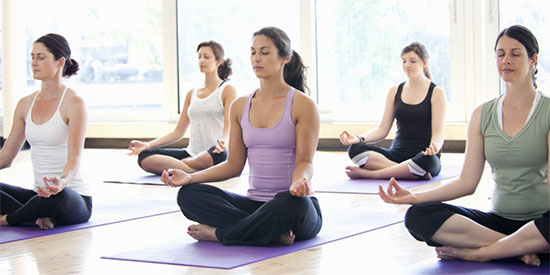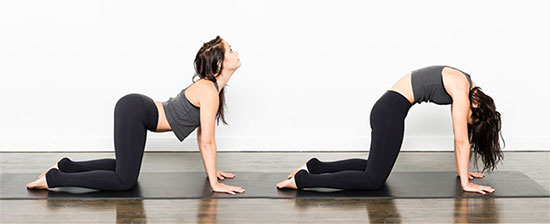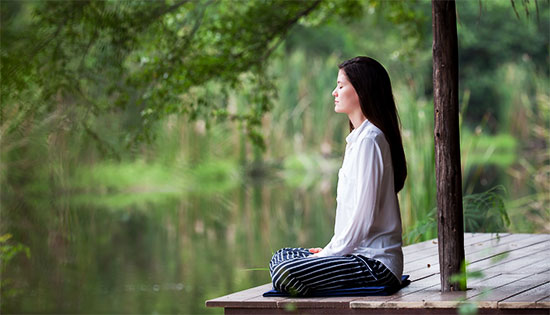How To Get The Most Out Of Your Yoga Practice

The practice of yoga is 100% a personal journey, and it’s never a competition. Let go of the idea that you need to keep up with the girl next to you or hold a plank longer than that guy behind you. And when all else fails, laugh whenever possible. Don’t take yourself too seriously.
Although the practice and general knowledge regarding the importance of yoga are spreading like wildfire through the West, it’s important to have a strong knowledge of what you’re actually doing in order to get the most out of your yoga practice. Yes, yoga is scientifically proven to decrease stress and improve overall well-being – a trait that does not go unnoticed, per the current explosion of mindfulness practices across the United States – but it’s not just because each yoga class makes us feel like a superhero. In fact, the physical practice of yoga is only one small part of it.
Similar to Buddhist teachings, yoga teaches us invaluable lessons and provides us with lifelong tools to sit with what is, whether “what is” is illuminating or uncomfortable. The ability to see life, ourselves, and each other clearly as we are right now – with a wide lens and laser focus – is what ultimately supports us in cultivating balance between highs and lows, ups and downs, and everything in between.
The ASANA (physical practice) is only one of eight “limbs” of yoga. Other best yoga practices include breathing exercise, how we conduct ourselves in life, self-discipline, and steps to meditation that result in enlightenment or feeling more one with ourselves. Moving into and out of postures in tandem with the breath provides a powerful platform for the mind-body connection, transforming our physical and spiritual selves from the inside out.
Although it is enough for us to get on a mat and try our best, it is also imperative to consider the quality of not only our poses, but also how we’re transitioning and how deeply we’re breathing if we are serious about sustaining our minds and bodies over time. This does not mean we’ll achieve full lotus and pretzel-shaped arm balances, nor should that ever be a requirement. But having this knowledge will give us the tools to have a lifelong yoga practice.
So before you pull on your favorite pair of leggings and hit the yoga mat, here are a few important tips and tricks that will help deepen your yoga practice and lead to a greater, more fulfilling mind-body connection.
Best ways to warm up
There are those who are flexible enough to touch their toes the moment they jump out of bed, and then there are those who might never be able to. Regardless, it’s beneficial to bring mobility to the muscles and joints before exploring more rigorous postures and transitions.
Child’s pose
Place the shins on the floor with the toes pointing back, bringing the big toes to lightly touch each other and the knees a bit wider than the hips. Rest the seat on the heels and lay the torso forward between the thighs so the ribs touch the inner legs, stretching the arms forward. Feel the subtle movement of the inhale and exhale as the spine tractions from shins to fingers. Take a few cycles of breath here, relaxing more and more with each breath.
Cat/cow pose

Come to hands and knees with shoulders stacked over wrists and hips stacked over knees. Spread the hands and shins evenly and firmly onto the floor so that the wrist creases are parallel to the front edge of the mat, or face the eyes of the elbows forward. On an inhale, widen the chest and lengthen the tailbone up in the opposite direction without pushing into the lower back, keeping the eyes and neck easy. On an exhale, lift the belly by pressing down into the floor and round the spine, broadening the upper back and letting the head hang easily between the arms. Breathe calmly in and out the nose, letting the breath guide each transition. Repeat for several cycles, noticing how the movement of the body connects to the movement of the breath.
Ankle-to-knee pose
Lie down on the back with knees bent over the ankles and feet flat on the floor. Cross the right ankle above the left knee so that the right knee bends open to the right, and flex the right foot so that the right ankle and knee stay in line. Remain here or draw the left knee into the chest, lacing the fingers behind the left hamstring muscles. Keep the eyes and neck soft. If lying down on the back is not an option, sit upright with one shin crossed in front of the other so that the ankles are more or less under the knees, and fold the torso over the legs by reaching the arms gently forward in front of the shins. Come out of either pose with control and repeat on the other side.
Bridge pose
Lie on the back with knees bent over the ankles with feet flat on the floor, arms by the side so that the fingers extend toward the toes. Press down evenly into the feet and arms to lift the pelvis off the floor, tucking the upper arms and shoulder blades gently in toward one another to create a solid base.
Remain here and place a block on the lowest or medium facet under the sacrum (that little triangle of fused vertebrae right above the seat/at the lowest part of the spine), making sure that the block is lying flat on the floor. Stay here for several breaths, keeping the eyes relaxed and the neck neutral. Avoid squeezing the buttocks muscles, and instead extend the knees away from the chest, pressing down evenly into the floor to broaden the collarbone toward the chin. Come down on an exhale, place the hands on the belly, and let the knees knock into each other for a few breaths before transitioning to the next pose.
Simple twist
Lie on the back with knees bent over the ankles, feet flat on the floor. Widen the arms to the side with the shoulders in line with the fingertips. Move the pelvis to the right and let the knees fall to the left, stacking the legs evenly at 90 degrees, knees at the height of the pelvis or belly button. Keep the shoulder blades even on the mat and place an evenly folded blanket between the shins if there is any pain in the back. Stay for a few breath cycles, noticing the movement of the breath in the entire torso: front to back, side to side, up and down. Draw the knees back up to flatten the feet, bring the pelvis back to center, and repeat on the other side. Roll to one side of the body before pressing up to sit.
Tips for a More Meditative Practice

Chances are you have experienced rushing to relax, or running to and from the yoga class to make it on time. Or perhaps you have stepped onto your mat only to be flooded by a to-do list, internal inquiries, and so on. We are humans, not robots, and it is natural to have thoughts. The practice of yoga exists to help us observe our thoughts as they come and go and practice resting in the space between them – or at least being able to identify what thoughts come up.
Label the breath as “inhale” and “exhale”
This is a concept from Buddhist meditation techniques. This can be translated to labeling sounds as “hearing”, sensations as “sensing”, or “feeling”, and thoughts as “thinking”.
Repeat a MANTRA or a force-idea
Do whatever feels appropriate at the time. It can be anything from a traditional Sanskrit MANTRA or phrase to something as simple as “I am”.
Set an intention
Keep the attention on it for as long as possible. Recognize when the mind strays, and return to the intention over and over again.
Keep the ears open
Actively listen to what the teacher is saying. Notice if your body is, in fact, implementing those instructions, no matter what anyone else in the class looks like or is doing at that moment.
If a posture or transition causes pain, back off.
Do the next best thing. We must trust our bodies – they are amazingly intelligent. Paying close attention to how we feel in the moment, listening attentively to the quality of our breath in each pose and transition will be tremendously beneficial in creating a more meditative environment.
Remember that meditation is not always easy
If something feels challenging and we are up for the challenge, we can choose to approach it with calm determination. Often students hold their breath with a motivational vigor – this is unnecessary and will only create potentially harmful patterns. Let go and release.
Essentials to make your sessions as comfortable and relaxing as possible
To get the most out of your practice, it’s important to keep tools on hand for both ASANA and meditation practice. Consider stocking up on the following supplies:
– The right yoga clothes. While leggings and yoga pants are everywhere, there are organic and eco-friendly yoga clothes.
– Yoga mat and mat spray. Various companies offer wonderful sustainable mats and great nonslip towels for sweaty places and practices.
– Essential oils. You can use lavender, rose, ylang-ylang, peppermint, or thieves blend, to calm mind and body. A few drops of tea tree oil with filtered water makes a good antibacterial mat spray.
– Cork blocks. You can simplify it by stacking up books too – those work just as well!
– Blankets. Whether they’re sitting around the house or specifically purchased for yoga only, blankets are important.
– Bolsters. These are especially important for restorative practices. You can easily substitute for a bolster by folding or rolling a few blankets together.
– Eco water bottles. There’s no need for all that plastic! Invest in an eco-friendly water bottle.
There will undoubtedly be obstacles and challenges, and there is always room to learn. But during the short time we have on planet Earth, why not enjoy the process as much as possible, even if it isn’t perfect? And do all our best to transform ourselves while on this journey…
yogaesoteric
December 20, 2017
